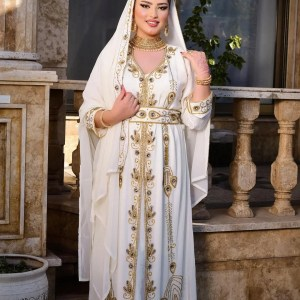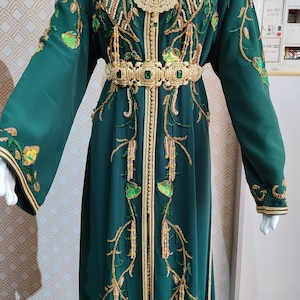- Published on
Unveiling the Timeless Elegance of the Takchita A Two-Piece Moroccan Gown
- Authors

- Name
- Adil ABBADI
Introduction

In the heart of Morocco, where ancient traditions meet modern flair, lies a treasured piece of cultural heritage – the Takchita. This stunning two-piece gown has been a cornerstone of Moroccan fashion for centuries, exuding elegance, sophistication, and femininity. In this article, we'll delve into the rich cultural significance, traditional significance, and modern relevance of this iconic garment, exploring its intricate designs, fabrics, and the women who wear it with pride.
- Cultural Context
- Traditional Significance
- Modern Relevance
- Cultural Preservation
- Conclusion
- Cultural Call-to-Action
Cultural Context
The origins of the Takchita date back to the 16th century, during the Saadian dynasty. This period saw a significant influx of Andalusian immigrants, who brought with them their rich cultural heritage and artistic skills. The fusion of Moroccan, Arab, and Andalusian styles gave birth to the unique Takchita, which soon became an integral part of Moroccan fashion.
Traditional Significance
In Moroccan culture, the Takchita is more than just a garment – it's a symbol of femininity, modesty, and elegance. Traditionally, the Takchita was worn by women on special occasions such as weddings, and family gatherings. The intricate embroidery, known as "tadel," showcases the artisan's skill and attention to detail, often taking months to complete.

Modern Relevance
In modern times, the Takchita has undergone a transformation, blending traditional techniques with contemporary styles and fabrics. The garment has become a staple in many Moroccan women's wardrobes, worn not only for special occasions but also as a fashion statement. The Takchita has also gained popularity globally, with fashion designers and influencers incorporating elements of the traditional design into their collections.
Cultural Preservation
Efforts to preserve and promote the Takchita are underway, with initiatives aimed at supporting local artisans and preserving traditional techniques. The Moroccan government has established programs to encourage the use of natural fabrics, such as silk and cotton, and to promote the work of local artisans.

Conclusion
The Takchita is a testament to Morocco's rich cultural heritage and its ability to adapt to modern times. This stunning two-piece gown is not only a reflection of the country's history and traditions but also a symbol of femininity, elegance, and sophistication.
Cultural Call-to-Action
As we celebrate the beauty of the Takchita, let us also acknowledge the artisans, designers, and women who have contributed to its legacy. Let us continue to appreciate and support the preservation of this iconic garment, and encourage others to explore the rich cultural heritage of Morocco.
